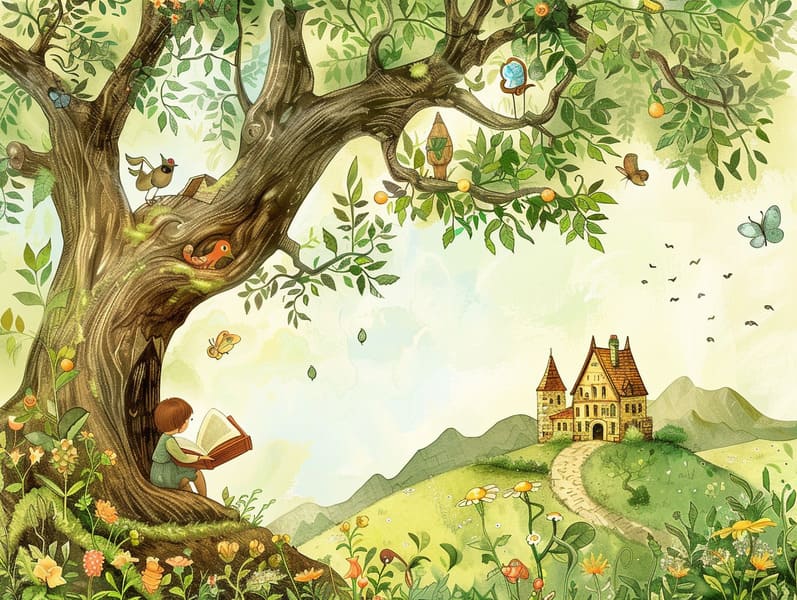
Grimm's fairy tales have ancient roots. These narratives have been shared from one generation to the next ages before they were ever transcribed. They originated from a variety of backgrounds, including European traditions. They were initially disseminated among adults, often carrying themes and messages concerning the societal norms and beliefs of the time.
The famous Grimm duo, the two Grimm brothers, were among the first to assemble many of these beloved tales. Their compilation, "Grimm's Fairy Stories," included stories like "The Little Glass Slipper," "Little Brother and Little Sister," and "The True Story of Snow White," which have since become hallmarks in the world of beloved fairy tales. Similarly, the Danish author's fantastical narratives, such as "The Sea Maid," and "The Little Duckling," have stolen hearts worldwide, ensuring their place in the pantheon of classic fairy tales.
Despite their historical roots, these tales remain as important as ever, especially as children's bedtime stories. These whimsical stories are now available in numerous formats, including vibrantly illustrated books, delightful animations, and internet fairy tales.
Their unwavering allure can be credited to several fascinating points:
Crucial Morals: Traditional fairy tales often teach important moral lessons. Narratives like "The Tale of the Boy Who Cried Wolf" teach the benefit of integrity, while "The Tale of the Tortoise and the Hare" highlight the benefits of persistence and modesty. These tales offer the young clear distinctions between right and wrong, forming their moral compass in a mild yet lasting way.
Empathy and Understanding: Classic fairy tales frequently feature characters facing struggles and tests, urging young readers to empathize with their struggles and champion their triumphs. For instance, "Beauty's Beast" shows us the merit of seeing inner beauty to see the real person of a individual, promoting perception and insight.
Cultural Awareness: Many ancient fairy tales are infused with the cultural contexts from which they were born. Discovering these narratives can provide delightful insights into different customs, building a sense of global understanding and discernment.
Fantasy and Innovation: The extraordinary elements in fairy tales—mythical entities—engender children’s visions and dreams. These stories guide readers to supernatural realms, fostering inventive ideas and a sense of mystery that continues a lifetime.
Ancient fairy tales are not only bewitching but also instructive. They work as magical tools in nurturing various mind and heart abilities in little ones. When old fairy tales are read aloud, they enhance communication skills by presenting new terms and meanings and complex sentence structures. This practice also nurtures hearing abilities and concentration, as children concentrate deeply, prepared to see what happens next.
Furthermore, contemplating the themes and characters of ancient fairy tales can cultivate evaluative skills and cognitive skills. Children learn to discern patterns, guess what will happen, and realize cause and effect. These debates also contribute to kids reveal their thoughts and feelings, boosting their emotional intelligence.
In today’s modern era, the availability of online storybooks has made these narratives more available than ever. Internet sites and programs make available comprehensive collections of ancient fairy tales that can be read or played anytime, anywhere. Fairy tales narrated are particularly liked, giving an enjoyable way for children to savor these captivating stories. Sound books and read-aloud videos transport characters and settings to life, often accompanied by fantastical melodies and music that raise the narrative journey.
The lasting allure of ancient fairy tales lies in their ability to change to new eras while preserving their core values. Contemporary revisions of these tales often bring in more multicultural characters and modern settings, making them understandable to today’s audience. However, the essential messages of boldness, generosity, and lawfulness remain unchanged, continuing to impact kids of all ages.
Ancient fairy tales also offer a sense of security and homeliness. They deliver up a methodical narrative with a straightforward beginning, middle, and end, often wrapping up with the settlement of conflicts and the triumph of virtue over corruption. This assuredness can be solacing for young ones, delivering a sense of reliability in an fluctuating world.
Ancient fairy tales continue to delight and guide new generations, maintaining their spell and relevance in modern society. As children's bedtime stories, they share a perfect blend of charm and understanding, nurturing moral values, empathy, and creativity. The availability of online fairy tales and the well-received status of fairy tales recited assure that these classic narratives remain obtainable to new generations.
By holding onto and sharing these narratives, we continue to praise the rich tapestry of narrative artistry and cultural heritage. Whether you are seeing a artistically illustrated book, delving into a electronic library, or listening via click here an read-aloud story, the captivation of old fairy tales is always within reach. These stories highlight of the immortal impact of tales and its ability to link us across epochs and places.
Even if you are enjoying a gorgeously illustrated book, browsing a virtual collection, or listening on an audio story, the charm of classic fairy tales is always within reach.
These narratives show us of the unfading effect of fairy tales and its ability to hold us together across generations and cultures, establishing a link that charms and informs alike.